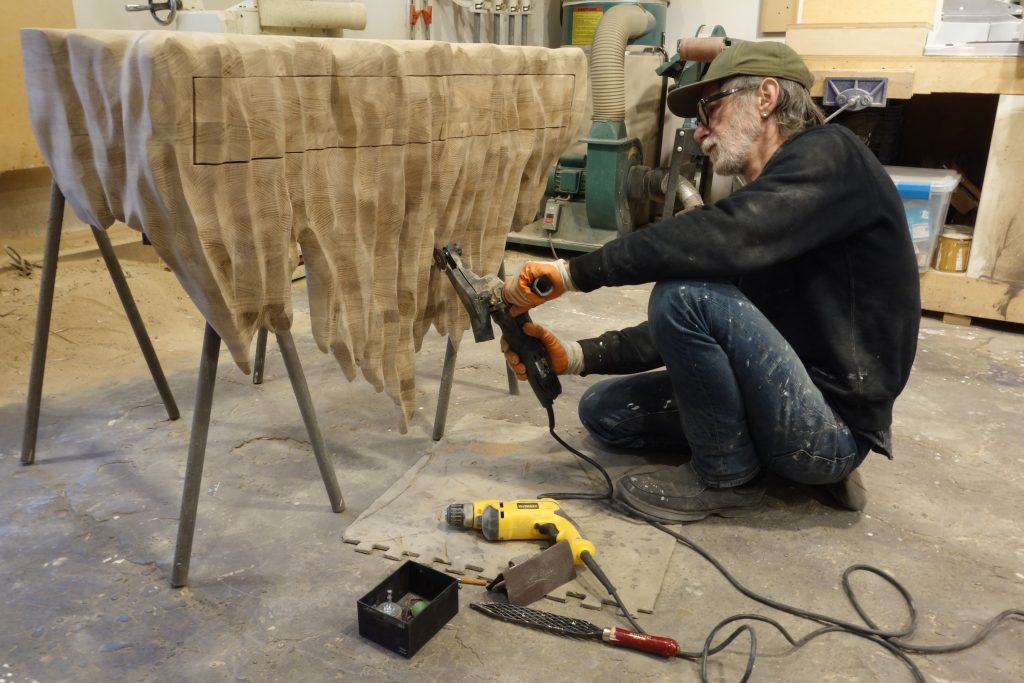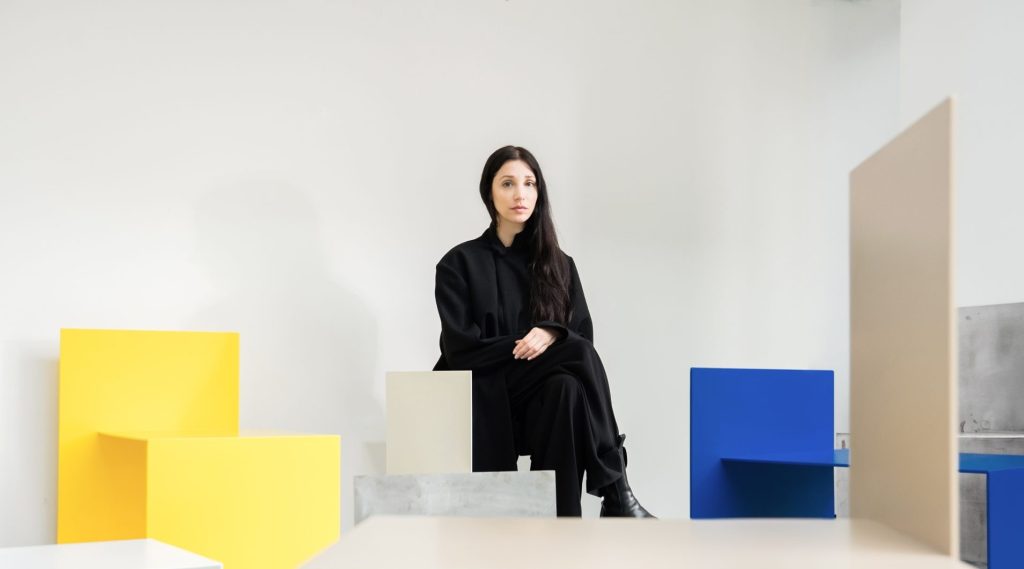
Kajsa Melchior: An Exploration of the Mind, Body, and Science
“I go to science for inspiration. As all living creatures, I love to learn. Being in “learning mode” has turned out to be the best way for me to activate my creativity.”
– Kajsa Melchior
View Kajsa Melchior’s showroom, including the “Four Elements” Pedestal >
For Stockholm-based designer and sculptor Kajsa Melchior, the complex relationship and dualism between mind and body is at the center stage of her design practice. However, she does not separate these two spheres. Throughout her work, Melchior fosters cross-fertilization of scientific, yet hands-on disciplines. The end results are ethereal pieces with organic shapes, resembling age-old geological formations given their unique texture through a sand casting method. Indeed, nature leaves an imprint on her work as each piece is a record of nature’s forces, demonstrating that the beauty of Melchior’s designs lies in their imperfections.
Melchior’s love for science, as well as her commitment to continuously learn and stay curious, is what inspires and informs her creative process. In particular, her educational background in interior design provides the necessary scientific tools and structure to realize her creative visions. This engages what she calls “the thinking mind”. Another part of Melchior’s process is connecting to “the thinking body”. It speaks for her intuition and desire to interact with the material, to use her hands, and to explore and feel its qualities. Through this playful, yet analytical exploration, Melchior establishes the boundaries of the material, or rather, the material teaches her about its functional and aesthetic limitations.
The ongoing series “Fictive Erosion”, in which Melchior manipulates her materials through wind, water, and her own hands, has grown within these parameters. Through this process, she achieves a texture and composition which never repeats itself and is naturally imperfect. For instance, the “Four Elements” Pedestal evokes feelings of curiosity in the viewer and invites them to ponder the boundaries between sculpture and furniture. In her upcoming additions to the series, Melchior has employed the same method, albeit experimenting with the potential of scale. This current fascination of hers led to the creation of new unusual shapes and forms.
On the surface, your background in interior design and architectural projects is quite different from your design practice. What drew you to the hands-on world of sculpture?
I have always enjoyed mixing different mediums while creating. I’m not a fan of dividing practices into specific fields. In secondary school, I was very into chemistry and biology. When I realized there was an option for me to study art, I thought architecture was a good option in order to keep standing on a scientific “solid ground” while still exploring art.
After school, I started to work at an architectural office and learned a lot about drawing techniques, and got an insight into how projects came to life from an early idea to a real, functional space. I enjoyed it [a lot], but I also started to feel some disconnection from my body. I realized that there is a distinction between – what I call, “the thinking body and the thinking mind”.
I felt an urge to create using my “thinking body” and [I] applied [it] to my studies through a master’s degree course at Konstfack in Stockholm, researching this theme. It was during these years I came to find my method of mixing mediums. I use science for inspiration, architectural practice to analyze the relationship between space, form, body, and movement, and my hands to investigate the material and its abilities and limitations.
In what ways do you incorporate your educational background into your work?
To me, it all comes together all the time. Everything you learn in life will stick to you one way or another. But, as I mentioned above, architectural practice is very much about understanding how form, scale, and movement act together in space. It is also very much about structuring creative work and [creating] frames for artistic explorations. I practice this education every day in order to find scientific reward in a quite free way of creating – or “playing”, if you will.
Organic shapes and textures play an important role in your practice, for example in the “Fictive Erosion” series. In what ways do these aspects allow you to experiment with different materials and methods of creation?
I go to science for inspiration. As all living creatures, I love to learn. Being in “learning mode” has turned out to be the best way for me to activate my creativity.
“Fictive Erosion” is a good example to demonstrate my design method. In this project, I learned a lot about erosion in nature and let the fact I learned become framed for different investigations. I call it “fictive” to make sure that I own all the rules. It is important to me that science, when it comes to my artistic practice, stands for the theoretical part. It is not physical, or true. It is informative.
For example: mechanical breakdown in nature means that the internal structure of a material restructures – like rocks. The wind repositions the material over millions of years creating formations with specific characteristics. In a chemical breakdown, the internal structure of a material changes – like ice, it melts and goes away. This kind of fact creates a rule in my practice.
I need to identify what properties a material I want to use has in order to find out in what ways I am allowed to affect it. It all goes this way, ending up in investigations with physical and theoretical diagrams comparing shape and function. I think materials are as capable of teaching us about form (and function) as we are teaching materials of how to behave and function. It is good sometimes to swap things upside down in order to look at it differently.
What was your approach when developing these series? For example, what mood were you seeking to create? How did you envision users reacting to these pieces?
I don’t create this way. I never see a mood or seek for reactions. My practice is quite centered around my own curiosity. But don’t take me wrong, I love talking about it and sharing my finds! I love when people get excited when seeing my work. The best comments for me are the speculative ones, like “what is this, it looks like a rock ….or an elephant leg”.
What was the main inspiration behind your upcoming collection of pieces?
Scale. I’m very into scale [at] the moment, which is a big challenge because of the physical limitations in the process. I love to work alone (only because it’s so much easier for me to play when I know I’m not watched) and the process is heavy. I have to dig big holes and carry a lot of water. Creating forms that intrude upon my own appearance is very appealing to me at the moment.




How, if at all, does your upcoming collection build on your previous collections? How does it differ?
The method is always the same. Not necessarily in performance, but in method. I’m seeking the same way, and probably also the same thing, even though I’m not sure what this is yet. I’m constantly looking for some sort of play between heavy and light, but can not put it in words at all.
Bio
Kajsa Melchior is an independent designer and sculptor based in Stockholm.
Her work has a design critical approach and investigates in the borderlands between furniture and sculpture, facts and fiction.
The work are explorations of how concepts such as developing and erosion can form the basis of spatial and material investigations, and challenges aesthetic standards as they are created through sand, compressed air and bodily imprints.












